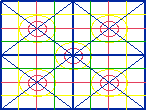
Parts of a Trading Day

 Technical Traders
Technical Traders
- Use Open, High, Low, and Close
- May add Volume and Open Interest

 Munehisa Homma (Sokyu Homma)
Munehisa Homma (Sokyu Homma)
- He designed the Japanese Candlesticks, and defined four parts to a trading day
- Head
- High in an up day
- Low in a down day
- Shoulders
- Close in an up day (top of candlestick body)
- Open in a down day
- Hips
- Open in an up day (bottom of candlestick body)
- Close in a down day
- Feet
- Low in an up day
- High in a down day

 The Waist
The Waist
- The waist is an additional part of the trading day added by T. H. Murrey
- It is calculated from the previous day's price action
- It is related to price momentum
- Support for an up day in progress
- Resistance for a down day in progress
- Basic formula for the waist (the 50% waist)
- (Open + Close) / 2
- (Shoulders + Hips) / 2
- Will be valid for a "normal" trading day (a "normal-sized" candlestick body)
- We should expect a fast reversal or a "gap" off any market that opens and closes on the "waist"
- Effects of Volume and the waist
- Volume will decrease or increase at the "waist"
- Low volume followed by a reversal or continued fall will indicate that our "waist" has been ignored, and should be adjusted
- Adjusting the "waist"
- If the previous day's candlestick body was extremely long, multiple "waists" will be generated
- If the "50% waist" is not holding, the "shoulders" of the previous trading day will be used as the "waist"
- A gap up or down shall void our waist for that particular day
- If the price action stalls out on a MML Line, then the MML Line is used as the
"major waist" and the 50% waist is considered to be a "minor waist"

 Bonnie's Links
Bonnie's Links
created by Bonnie Lee Hill,
 bonniehill@verizon.net
bonniehill@verizon.net
 last modified on February 9, 2020
last modified on February 9, 2020
URL: http://mysite.verizon.net/bonniehill/pages.aux/murrey/waist.html



 Return to Murrey Math
Return to Murrey Math
 Technical Traders
Technical Traders
 Munehisa Homma (Sokyu Homma)
Munehisa Homma (Sokyu Homma)
 The Waist
The Waist Top of Page
Top of Page
 Return to Murrey Math
Return to Murrey Math Bonnie's Links
Bonnie's Links bonniehill@verizon.net
bonniehill@verizon.net last modified on February 9, 2020
last modified on February 9, 2020